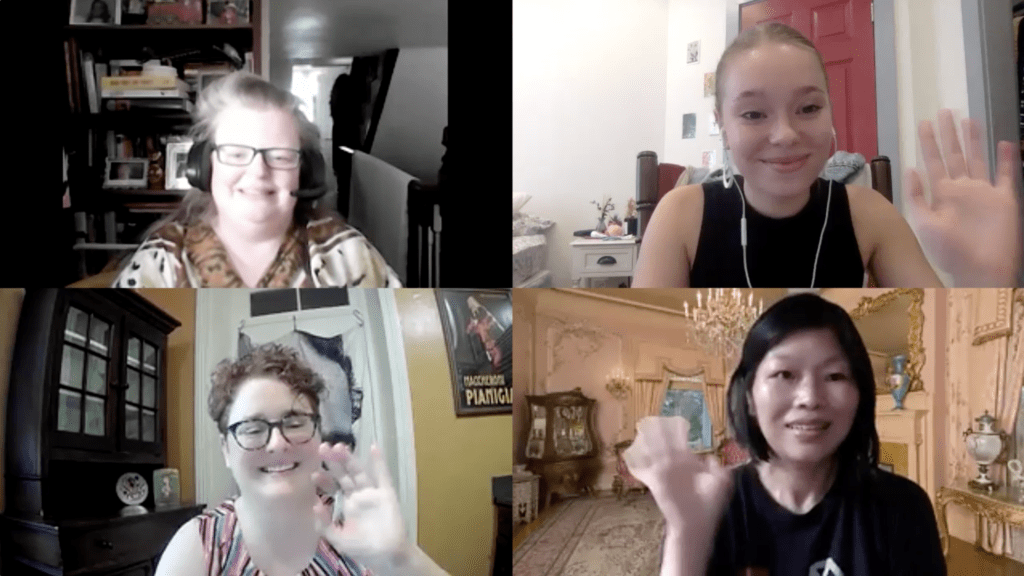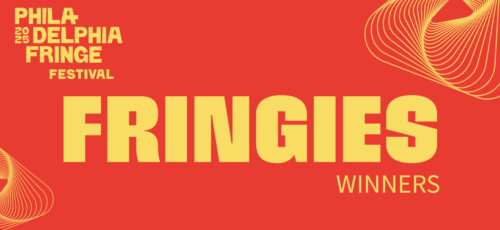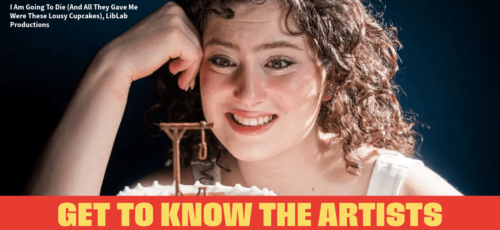Independent Artist Spotlight: Stephanie Parker & Friends’ International Women’s Public Safety Clown Army
Edit: This event has passed.
—
Covering everything from car accidents, to scaffolding falls, to reproductive rights, the International Women’s Public Safety Clown Army uses clown humor in their round-table event to discuss the serious issues surrounding being a woman in public.
At first glance, the Women’s Public Safety Clown Army seems to be a ride for audiences. Upon closer look, the show is even more unexpected, out-there, and hilarious – if you can believe it. Driven by their organizer, Stephanie Parker, a group of 5 clown-identifying women from across the world will be meeting on September 11th, 2021, for a one-night-only, online round table on women’s public safety. Spurred by the individual experiences of the women involved, the event becomes a safe space for these women in comedy to band together and support each other in sharing their stories with the public, with an emphasis on the importance of community. “I think what all of us are saying is, my takeaway, for me, is you just want to be around like-minded people. You have to find them, you have to congregate often” explains Stephanie. Community is built on multiple levels through the International Women’s Public Safety Clown Army, as is apparent from the title alone. “Both my LA clown teacher and my U.K. clown teacher, they want to build communities. And I think we have to! Because if we were to study very traditional clowning, it’s very patriarchal… I don’t want to be oppressed there, especially when I’m trying to develop and find my creativity”. Navigating the issues of womanhood and safety across the world, while coming from the informed backgrounds of being women in comedy, allows for a round-table experience that you could never find on Sunday morning TV, but you’ll be wishing you could.
The International Women’s Public Safety Clown Army consists of the five clown-identifying women; Stephanie Parker, Margo Carr, Sonja Pacho, Srilatha Rajamani and Desiree Walsh. Beyond the women behind the army, one might beg the question, what is a clown army? “It’s a bit of a fever dream,” begins Parker when recounting the conception of the group. “… I was going out one day, and I don’t like the sun, so I was covering up, and I looked a bit crazy- somebody said I look like a burn victim when I get ready to go outside… I got this mask and I thought it was really cool, and then I have this big hat and everything…”
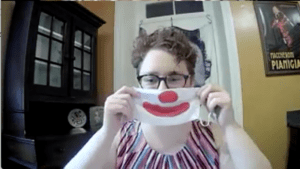
Stephanie Parker showcasing the mask she was wearing the day of the accident.
“ I went to the post office to run some errands… I was at this very busy intersection which was a four-way stop sign, and this white SUV rammed me as I was crossing, like, in the zebra crossing… and everyone was incredulous! And then my hat flew off, and I had to run back into the street and get my hat… My last name’s Parker, I feel like I Spiderman’ed it, like I went up on his hood and I got caught up in his window wipers, and I was just bruised and scraped. He didn’t run me over, I didn’t crack my head, you know, and I was just like, ‘Really!?’ Like, how do you not see me, I look completely ridiculous!… I’m just screaming profanity… I was so mad about it, and I was just more angry than anything… My boyfriend picked me up, and I got in his car, and I start my story and I say ‘Well when this happened to me last time,’ and he just lost it there, he’s like ‘This happens to you repeatedly!?’. This happened to me when I was in college like 20 years ago or something, and again I was more annoyed- it’s disruptive, I’m not scared, I’m not annoyed or upset, I’m mad.”
From that terrifying accident, the gears began to turn for the International Women’s Public Clown Army, as Stephanie shared her experience with friends and family. “After my accident everyone’s like, is this a bit? Like, this really happened? Even like two weeks later when I’m still traumatized by it, ‘Oh, that was for real’. So that’s extra funny, but right away Sonja’s like ‘Oh my god, sketch ideas!’ and one of my clown teachers was like ‘Oh web series!’”. To make the situation even worse, and funnier, Sonja Pacho then shares that she has also experienced a near-death accident due to public negligence. “I’m seriously accident prone, I’ve been hit by a car too while crossing the street, but I was in a scaffolding collapse where I just thought it was over. It involved two taxis, it was slightly raining- this was in New York City. One ran a red light, hit another one, swerved out of control and drove into the scaffolding I was standing under. So I guess I’ve had a fear of scaffolding since… And I was a witness to a huge scaffolding accident, similar thing, college kids driving a U-Haul, crashed into the pole, the whole thing came down. And the way they popped out of the van was like a clown car kind of, and there’s like 20 stories of scaffolding collapsing”
Collisions of traumatic events and humor begin to form something new, as the group of women share these moments that will stay on their mind forever- and the inherent clowniness behind them. Margo Carr shares her own connection to the project as being a dark yet somehow comedy-inducing experience growing up in Ireland. “I actually was born in Scotland but was brought up in the south of Ireland, and when we came back from Scotland in the 70s, it was like you’re coming back to somewhere where there’s no rights for women. When I was a kid, even if you had a joint account with your husband, you couldn’t even take money out unless he signed a form for you to let you do it… It’s quite serious actually… Pretty much, if there’s something they can keep women down with, even to this day they will do that, so that’s where I come from with my gripe, with my joke… It’s pretty damn serious but hopefully there’ll be some laughs as well!”.
Part of the beauty of clowning is the ability to take a serious or uninviting situation and push the limits of that situation with sheer ridiculousness. The experiences shared by these women highlight deep problems in public safety, government negligence, and oppression, however they are able to balance the severity of these forces with their lighthearted, comedic sensibilities. “All this stuff, it’s so heavy and personal, but then it’s so cathartic, and as comedians we’re willing to share these things, and I don’t know if people are gonna be ready for them but, you know, we’re gonna find out” Stephanie shares, as Sonja cuts in, “I think it’s hilarious! I mean if someone told me this stuff I’d be laughing. Also like, ‘Oh my god I’m so sorry!’”.
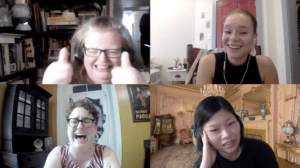
Margo Carr (top left), Stephanie Parker (bottom left) and Sonja Pacho (bottom right) having fun discussing the International Women’s Public Safety Clown Army with Intern Maria!
What some may be wondering now is, what even is a clown? If you’re imagining a person with a big red nose, a painted face, and oversized shoes, then you’re technically right but also wrong. “The deepest question yet” responds Stephanie when asked herself what it means to be a clown. Margo continues, “Clowns? What the hell? But being an actor and a comedian, it came into some of my training, and I was like ‘Oh wow!”. I don’t have to have a red nose on, it’s just a particular way of carrying yourself, or a particular way of reacting to things, and I am a clown! Because I am accident prone, and I do offend people as well but not mean to because I’m being honest or I’m being funny… So yeah, there is a clownishness about me. And I fall over, and I have bashed my head, and I have scratched my leg and ended up in the hospital because of it… And I’m jolly, and I’m overweight, and it’s like, she has to be funny!”. Sonja adds her own experience, “My friends have said that I’m fearless, which I always find a disconnect because I’m so afraid of things, like I didn’t do improv or clowning because I was afraid to do it. So that always felt like, you think I am? So it’s maybe just exploring that. Like, am I? Can I just do whatever, can I say what I want, can I do what I want? Clowning and fear, it’s not the fear of clowns, it’s the fear of doing. I think it’s helping me a lot”.
How does one express their clown identity at a round-table event? Stephanie explains, “It’s sort of like watching a cartoon that’s good for the children and it’s good for parents! I think clowning works on many levels, and this is just another exploration for me, and for the show”. Being a one-time, unrehearsed event, the elements of surprise and reaction truly come into play at this round-table. While the messages being conveyed are known to the women, the means of getting there becomes the most clown-like part of the event. Sonja expands upon this idea of spontaneity and the unknown, “I think that is an inherently clown thing, to react to what someone says or does, but also say something in that too. It’s like the unknowing, the spontaneity and reacting- that is a goal, at least in my clowning. To accept what’s been thrown at you and make something out of it… I’m half Filipino, and there’s this saying in Tagalog ‘bahala na’. There are different interpretations of it. One is fatalistic, this is happening to me and I have no control. But there’s another view, the opposing view which is… taking control of what’s not controllable”. The uniqueness of the participants and their experiences, mixed with this aspect of uncertainty, makes for a dynamic conversation that is irreplicable outside of the night that it all comes together.
Obviously, however, this round-table is more than a bunch of feminist-clowns joking about life’s horrible events. The event becomes a meeting ground for women, specifically women in a majority male dominated field, to unapologetically speak about themselves and the way they experience the world. Personal histories, funny anecdotes, and political issues will be addressed throughout the night, creating a larger dialogue about what it means to be a woman, and how that can be reacted to. Stephanie continues about her experience being hit by a car, “And ironically, my next stop was to go buy feminine hygiene products, and maybe this plays into the feminism, I don’t know… I was not gonna let that man and his dumb car slow me down. The pandemic. The summer. The sun. All these things bother me to varying levels, so it was this layered thing”. Layers of comedy, clown, and feminism come together, making a relatively heavy topic of conversation approachable for larger audiences- not just feminist-clowns”.
“Being a feminist, I didn’t even used to say that I was one, and now I have a daughter… I can’t not be. There’s nothing wrong with being a feminist cause you want rights for everybody, not only yourself and women. You want rights to just be a thing we all have. That’s not unreasonable. Anyway I’ll get off my soapbox now” states Margo, highlighting that while this round-table is political in nature, it’s not just a soapbox for these women. It’s still a comedic event, which shines through all of their personalities while discussing the issues at hand. “So we’re like, holding up a mirror, and talking about real issues, and serious things, but also being very funny about it” says Sonja, with Stephanie continuing, “It’s a fun house mirror!”.

Desiree Walsh (top) and Srilatha Rajamani (bottom) are also feminist clowns participating in the round-table.
When asked if the International Women’s Clown Army will continue after the round-table on September 11th, Stephanie jokes, “If it doesn’t go horribly maybe?”. Sonja adds that this is a topic that they could talk about as a group forever, and Stephanie continues, “Til we die! Hopefully not by scaffolding, or cars, or lack of rights”. Whatever happens on the night of the round-table, it can go without saying that it will be a thrilling journey to hear about the experiences these women have been through and how they use comedy to frame them. While Srilatha and Desiree could not join in the pre-show discussion, it is safe to say that there will be even more shocking, and frankly, insane, content to be shared when they are all able to come together. “We’re gonna get more recruits. This will be like a recruiting video for… I don’t know, world domination? That sounds creepy” Stephanie jokes about the impact that the inaugural International Women’s Clown Army round-table will have on the future of women’s public safety and feminist clowning. In order to be a part of the event yourself, and to get some good laughs, be sure to attend the online event, Saturday September 11th as a part of the 2021 Philadelphia Fringe Festival!
Article by Maria Dragone, Photojournalism Intern

